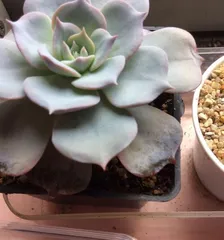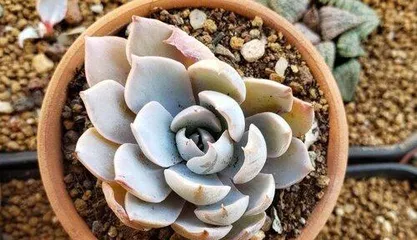Echeveria Blue Stone is a beautiful succulent plant with unique shapes and colors, loved by enthusiasts. However, sometimes we find that its leaves become soft, even rotting. How should this situation be handled? This article will introduce you in detail to the causes and solutions for soft leaves of Echeveria Blue Stone, helping you better care for it.

Understand the growing environment of Echeveria Blue Stone
Echeveria Blue Stone is a plant that grows in dry areas, liking sunlight and ventilation. If the environment is too humid or lacks ventilation, it can easily lead to softening or even rotting of Echeveria Blue Stone leaves.
Pay attention to watering
The amount of water for Echeveria Blue Stone should be appropriate, neither too much nor too little. Excessive watering can cause overly wet soil, leading to root rot; insufficient watering will result in dehydration of Echeveria Blue Stone, making leaves dry.

Choose suitable soil
Echeveria Blue Stone has high requirements for soil, requiring special succulent soil with good breathability and drainage. If the soil is not suitable, it can affect the growth of Echeveria Blue Stone, causing leaf softening.
Control temperature
The temperature adaptation range of Echeveria Blue Stone is relatively narrow, generally between 15°C and 25°C. If the environmental temperature is too high or too low, it will affect the growth of Echeveria Blue Stone, resulting in soft leaves.
Avoid direct sunlight
Although Echeveria Blue Stone likes sunlight, excessive sunlight can damage it, causing leaf softening. During hot summer periods, Echeveria Blue Stone should be protected from strong direct sunlight.

Pay attention to fertilizer use
Echeveria Blue Stone has small fertilizer requirements, generally once a month is sufficient. Excessive fertilizer use can cause salt accumulation, making the soil overly acidic, leading to leaf softening of Echeveria Blue Stone.
Deal with soft leaves promptly
If you notice softening of Echeveria Blue Stone leaves, timely measures should be taken. First, cut off the affected leaves, clear the surrounding soil, disinfect, and then cover with new soil.
Prevent and control pests and diseases
Echeveria Blue Stone can also be affected by some pests and diseases, such as powdery mildew and red spider mites. If not controlled in time, they can seriously affect the growth of Echeveria Blue Stone, causing leaf softening.
Properly prune branches and leaves
During growth, Echeveria Blue Stone produces old leaves and dead branches, which should be pruned in time. This not only maintains the aesthetic shape of the plant but also promotes new shoot growth and enhances the vitality of the plant.
Increase environmental humidity
In dry environments, Echeveria Blue Stone is prone to soft leaves. You can appropriately increase environmental humidity, such as placing a pot of water nearby or using a humidifier, to help maintain an optimal growing environment for Echeveria Blue Stone.
Pay attention to transplanting timing
Echeveria Blue Stone is suitable for transplantation in spring or autumn, not in summer or winter. When transplanting, use fresh soil and carefully dig out the roots to avoid damaging them.
Control fertilizer application
Echeveria Blue Stone does not require much fertilizer, once a month is enough. Do not apply too much fertilizer at once, otherwise it can cause poor absorption by roots, leading to leaf softening.
Regularly loosen the soil
Regularly loosening the soil makes it loose, increasing air permeability and drainage, which benefits the growth of Echeveria Blue Stone. But be careful not to loosen the soil too deeply to avoid damaging the roots.
Avoid frequent moving
Moving Echeveria Blue Stone should be minimized because frequent movement can affect its growth, causing leaf softening.
Echeveria Blue Stone is an easy-to-care-for succulent plant, but there are also some points to note. If leaf softening occurs, you can investigate and handle according to the above 15 aspects. Paying attention to the growing environment, watering, choosing suitable soil, controlling temperature, etc., can all help us better care for Echeveria Blue Stone and keep it healthy and beautiful.
<|end_of_box|>